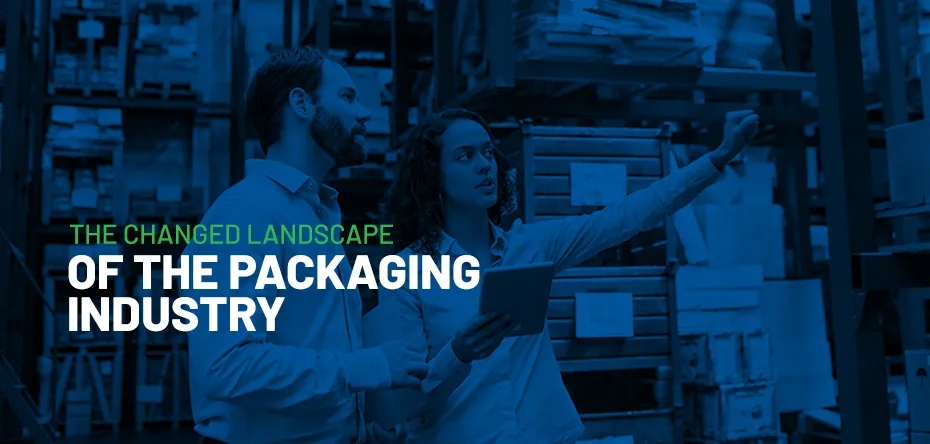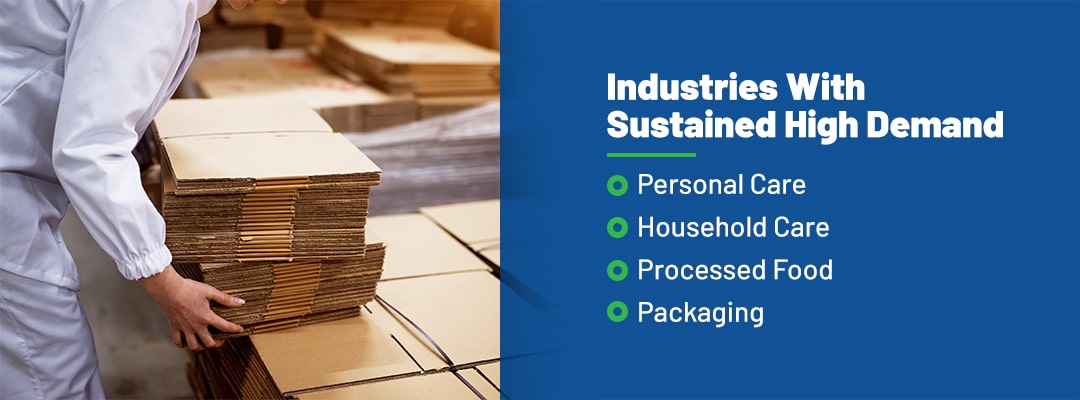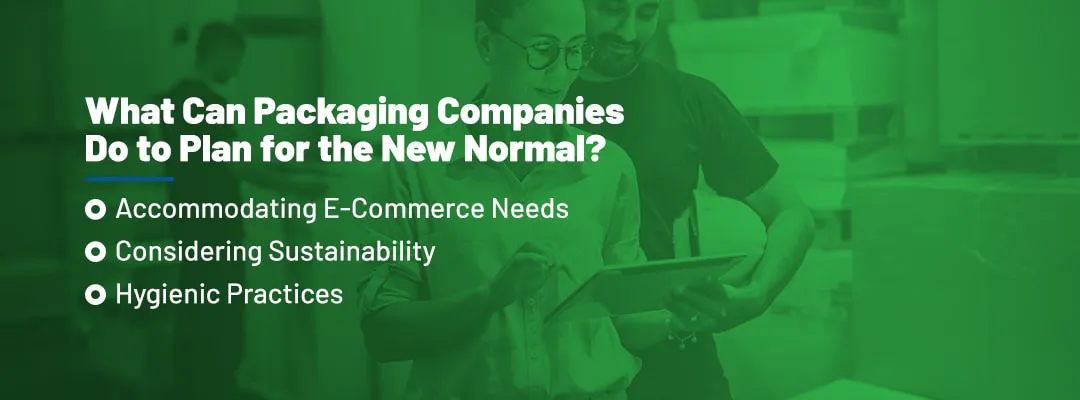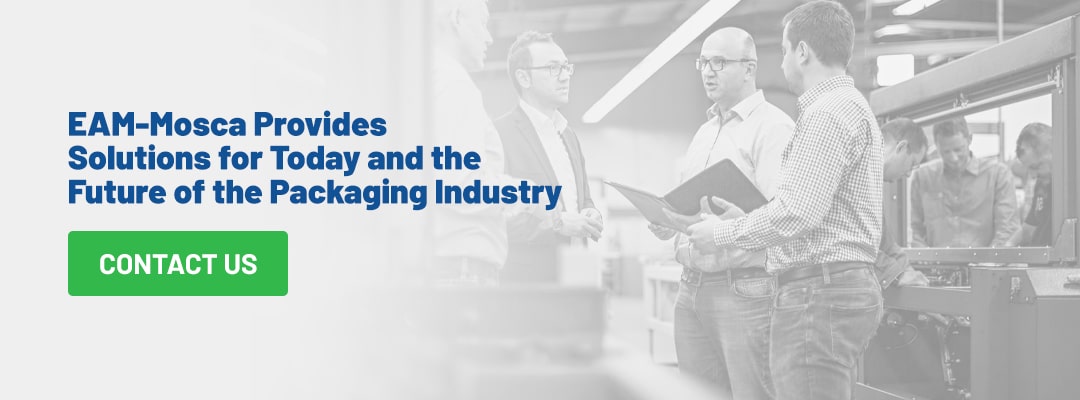The Changed Landscape of the Packaging Industry
Though the COVID-19 pandemic severely impacted numerous businesses around the globe, the packaging industry remained robust. Its essential nature allowed this sector to continue operations at near-full capacity, and the unique demands of the surge in e-commerce stemming from the pandemic resulted in innovation rather than stagnation. Changes occurred for all players within, serving, and served by the packaging sector.
Some industries that rely on packaging also had increased demands, such as processed food, household care, and personal care. As consumers in lockdown or quarantine turned to online shopping for groceries and essentials, the natural result was an increased need for quality packaging for shipping.
This increased packaging demand due to the COVID-19 pandemic also extended to other industries. For example, restaurants reduced business and school cafeterias no longer served food when schools closed. Food suppliers to these companies switched from packing bulk orders of food to smaller containers for consumers to purchase at stores. Packaging companies had to respond by providing solutions for smaller container sizes and fast packing.
Consumer behavior goes beyond affecting the industries that directly serve people, also impacting the packaging sector that supplies those consumer-centered businesses. To identify packing industry trends today and into the future, the relationship between this sector and consumer behavior requires close examination. To thoroughly evaluate this connection, we have to recognize the effect of COVID-19 on packaging and the changes in the industry arising from the pandemic.
1. COVID-19 and the Rise of E-Commerce
Packaging demand changed during COVID-19 for several reasons. First, greater e-commerce demand changed how consumers made purchases. Consequently, this shift changed the way companies needed to package their goods, as they were now making direct sales instead of bulk shipments to retailers.
More Web Purchases Than In-Store Buying
During the pandemic, consumers turned to making web purchases for necessities instead of going to stores. This behavior contributed to the already swelling rise in e-commerce. During the second quarter of 2020, when many lockdowns went into effect, retail sales shrank 3.6% overall compared to the same quarter in 2019, but e-commerce’s share of that total figure increased by 43.8%. The pandemic accelerated e-commerce growth by two years, propelling it to numbers it wasn’t expected to reach until 2022.
Today, e-commerce sales continue to rise. The first quarter of 2021, which was still subject to the pressures of the pandemic, had a 39.3% increase in e-commerce sales compared to the first quarter of 2020, which was before the pandemic reached full force in the United States. Since the fourth quarter of 2020 through the second quarter of 2021, e-commerce has remained a significant portion of the retail economy, at a stable 13.6% of total sales.
With more demand for online shopping, manufacturers must package goods differently to accommodate direct-to-consumer sales.
Another change to the web shopping experience has been the rise of competitors to Amazon. In 2019, the company accounted for 43.8% of e-commerce sales. By 2020, it dropped to just under a third of the online shopping market. The rise of online sales from retail stores contributed to other sellers taking some of Amazon’s market share. Online sales from existing retail stores showed the biggest growth in e-commerce during 2020, with a 76.8% growth compared to a 37% increase in web-only store sales.
Products Shipped Directly to Consumers Require Different Packaging
Rather than packaging items in bulk to send to retailers, companies are seeing an increasing need to send individually packaged products directly to consumers. The buyers want to have packages that protect the goods inside during shipping and open easily upon arrival. For instance, individually packaged sets of plasticware for restaurant takeout orders became more popular as consumers got more food delivered instead of going out to eat. Sellers of the plasticware had to shift from selling bulk containers of forks, knives, and spoons to providing single-use sets.
The changes in packaging to meet the increase in online sales and consumer expectations impacted several sectors that sustained high demand during the pandemic.
2. Industries With Sustained High Demand
Despite the economic upheaval the pandemic caused, not all sectors lost money. Several industries maintained or saw elevated demand even during the lockdowns as consumers’ needs shifted. Personal care and household products enabled people to maintain good hygiene and keep their surroundings clean and sanitized. Processed foods helped people cook easy meals at home during lockdowns. Packaging consistently remained in demand to help companies shift their production processes to meet consumer needs.
Personal Care
Demand for personal care products such as soap and hand sanitizer rose sharply as consumers used these products in greater amounts than before. Plus, some of the additional sales at the beginning of the pandemic may have come from panic-buying. However, as time went on, sales of personal care products continued, which prompted many companies to amend their production lines to accommodate the greater need for consumer-sized packages.
Household Care
Household care products, such as surface cleaners and sanitizing sprays, stayed in high demand as more people stayed home and sought to keep their living spaces as germ-free as possible. As with personal care products, manufacturers had to shift packaging to allow for more sales directly to consumers.
Processed Food
Many restaurants closed during the worst of the COVID-19 pandemic, prompting people to choose prepackaged processed food in greater amounts. For example, frozen foods sales in April 2020 were up to 35% higher than the year before, which came immediately after a 94% spike in sales during March 2020. People at home during lockdowns chose frozen foods to stock up on provisions that stayed good for a long time and were easier to prepare. Stocking up helped them avoid unnecessary trips to the store and anticipated product shortages.
To accommodate this trend, the packing industry had to help sellers provide more retail products instead of selling large containers of bulk food products to restaurants. The increase in frozen food sales illustrated a need for more containers that allowed buyers to easily heat and serve foods.
Packaging
The change from industrial or commercial-sized packages to individual, consumer-sized containers required shifts in production and packaging lines to meet the demand. Consequently, packaging benefited from the change in personal care and other industries that saw great need for their products. Increased automation, new packaging lines, and faster processes became solutions to many companies’ changing needs.
3. Touchless Experiences
As consumers sought alternatives to in-store shopping, many opted to buy online while others chose contactless curbside pickup from local retailers. For instance, instead of dining out, consumers increased their use of restaurant delivery services and curbside takeout. In a survey of consumers, 51% reported using curbside restaurant pickup more than they did six months before and 30% indicated using restaurant delivery more.
Another area of increased touchless service during 2020 was grocery delivery, which rose 146% compared to the year before. With restaurants closed, shoppers both increased their grocery store purchases and used delivery services more for contactless shopping.
E-commerce portals also met the need for contactless shopping, and they’re not going away. Consumers can purchase online through many different services and have goods delivered to their door without leaving their homes. The demand for online ordering and touchless delivery from e-commerce or pickup services has only increased the need for durable pouches and other flexible packaging options.
4. Sustainable, Sanitary Plastic Packaging
Consumers rank sustainable packaging low among factors they use when making buying decisions, with factors such as price or convenience often playing a larger role. However, half of today’s buyers report concern about the environmental impact of packaging products. Even with their conflicting interests, many still feel open to paying more for more sustainable packaging, provided the packaging informs them of its greener nature. As such, solutions that meet the need for both convenience and sustainability will become essential to the future of the industry.
More Single-Use Plastics in Demand to Maintain Sanitation During COVID-19
The pandemic made consumers more aware of the need for hygienic solutions and food safety, with 77% citing these factors as important for packaging. Individually packaged single-use products meet these needs. Restaurants that catered to takeout customers began using packaged sets of plasticware to maintain more hygienic conditions for takeout orders. Similarly, the increase in frozen foods heightened the demand for single-use plastic containers for food.
However, the need for more plastic packaging does not mean that consumers don’t want sustainable options, as they still show a preference for recycled goods and packaging that they can recycle.
Finding Sustainable, Disposable Options
Sustainable options for packaging should come from pre- and post-consumer recyclables. For instance, consumers in the future will want more fully recyclable plastic film on packaging or films made from sustainable materials. Plastic packaging made from recycled products ranks as one of the top plastic options available today, with consumers preferring this option over metal, glass, and other containers.
Polyester (PET) strapping materials that are both recyclable and made from pre and post-consumer recycled PET meet this demand by consumers and the companies that cater to them.
5. In-House Packaging Equipment
COVID-19 did not impact the packaging industry to the same extent as it did other sectors. More than four in five companies (83%) reported near-full-capacity operations during the pandemic due to the rise in demand.
To handle the surge, companies replaced their existing packaging machines with more efficient models or opted to upgrade to automated designs. These changes prompted a record 12% rise in the sales of packaging machines from U.S. builders.
Another change for the industry was the rise in demand for remote technical support. Remote troubleshooting and technical support helps overcome the challenges arising from travel restrictions present during the pandemic. Plus, this option allows for faster responses to common issues. Should remote troubleshooting not work, the process can still gather vital information for field technicians to use when they arrive for in-person repairs.
What Can Packaging Companies Do to Plan for the New Normal?
The major shift in consumer patterns spurred by the pandemic has affected the future of the packaging industry on multiple levels. Packaging companies can rise to the challenge by meeting increased e-commerce needs, choosing sustainable options, and maintaining hygienic practices within their facilities.
Accommodating E-Commerce Needs
First, companies should continue to meet the needs of e-commerce sites by creating shippable, protective containers and consumer-sized packages. By 2024, up to 70% of worldwide consumers may shop for groceries online, increasing the need for consumer-level packaging that ships easily. Consumers will also continue to demand easy-to-open and resealable packages.
Companies should prepare for an increase in commercial packaging as more businesses resume operation after lockdowns. Some companies that scaled down their offerings and provided fewer package options may return to pre-pandemic production levels, requiring more packaging equipment to meet their needs.
Considering Sustainability
Sustainable packaging was an important issue before the pandemic and will continue to remain vital in the future. Finding sustainable plastics is important due to the rise in plastic use — which is now 20 times the rate seen 50 years ago. Plastics remain a constant in packaging thanks to their durability and ease of use. The frequent application of plastics in many products and packages means this material will be difficult to completely replace. Finding ways to make plastic use in packaging more sustainable may define the future of the industry.
Consumers and businesses recognize the environmental damage done by disposable, single-use plastics. Therefore, they will increase the demand for packaging and products that use recycled materials and can be recycled again.
Hygienic Practices
In 2020, many facilities shut down during the early days of the pandemic to prevent the illness from spreading among employees. Essential industries, including the packing sector, did not have this luxury. Businesses in this sector had to take different measures to make workplaces more hygienic and promote safe work practices.
Hygienic practices within packaging facilities include spacing out workers to prevent viral spread and reducing the total number of people in an area at a time. Automated packaging equipment can support these measures by helping facilities operate with fewer staff members. Plus, the automation reduces worker contact with surfaces and products, which can keep workers and consumers healthier. Keeping workers spread out, encouraging good hygiene practices, and requesting regular surface sanitation can also keep those at the facility healthy.
Even after the pandemic passes, the same measures used to maintain a hygienic work environment will likely prevail to prevent the spread of colds, cases of the flu, and other illnesses.
EAM-Mosca Provides Solutions for Today and the Future of the Packaging Industry
The team at EAM-Mosca offers solutions that support the existing packaging needs of companies while continuously innovating to meet future demands. For more than three decades, they have produced premium strapping machinery and products that overcome the challenges inherent to this field. By placing our expertise and focus only on what we do best, we can adapt to the changing needs of the packaging industry.
With the innovative Sonixs ultrasonic sealing technology, they have changed the face of packaging by providing a no-heat sealing option for more reliable, efficient strapping. By continuing to innovate, EAM-Mosca supports manufacturers in their ongoing goal of increasing productivity and moving more product than ever before. Contact us today for a quote to access future-focused packaging technology for today’s operations.






